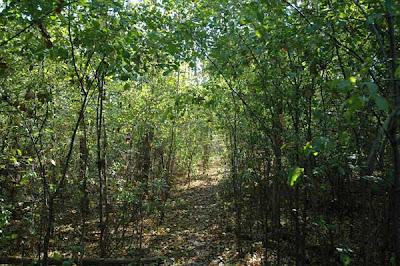We are getting near the end of our seed collecting. Today, Kathie collected heath aster (
Aster ericoides) and I collected Tinker's weed (
Triosteum perfoliatum).
Heath aster is interesting because it is one of the first plants to appear in the spring, yet it doesn't flower and set seed until late fall. This is a species that forms clones or fairly large patches, and in the spring the leaves are soft and green. As the season wears on, the plants get progressively rougher, until by the time they are flowering in mid October, they are beginning to feel like a Brillo pad. (I suppose that is why it is called "heath" aster, since plants of the heath family have a similar appearance).
Heath aster is a dry prairie species, and at Pleasant Valley Conservancy we found lots of it on our very dry and severe south-facing slope. This year, the plants there flowered poorly and seed set was really bad. After an hour, Kathie gave up and went to the Cabin Prairie, a mesic prairie where most species grow better. She found several good patches of heath aster and was able to get some nice seeds.
When looking on web sites, I discovered that there are quite a few cultivars of heath aster that are sold to gardeners. I assume gardeners like it because it flowers late, and the large clumps and patches are quite showy.

I collected Tinker's weed fruits in two of our savanna areas. This plant, sometimes called feverwort, late horse gentian, or wild coffee, is a characteristic savanna species, at least at Pleasant Valley. We don't find it in any prairies, and in our oak woodlands it is very scattered, but there is a lot of it in the savannas. Although the flowers are not very showy, just tiny reddish ones in the axils of the leaves, the leaves are quite distinctive. There is almost always someone on any of our trips who asks what it is.
As the photo shows, it forms fruits that look like tiny tomatoes. Not surprisingly, the homeopaths have found some uses for these fruits, but I suspect like most of these so-called remedies, it is worthless.
When you collect Tinker's weed fruits you are actually cleaning them at the same time. The trick is to cut the stems with all the fruits intact, carefully turn upside down in a bucket, and then quickly strip off the seeds. They are dislodged easily and fall the bottom of the bucket. In a half hour I easily collected a pound of fruits.
According to Cochrane and Iltis, Tinker's weed likes "heavy" soils and is absent completely from the Central Sands. It also grows poorly or not at all on soils derived from St. Peter's Sandstone. Perhaps this species is a calciphile.
Today we also picked up our tractor from where it had been serviced in Sauk City. We ate lunch in Prairie du Sac and stopped at the bald eagle viewing site along the Wisconsin River. Not an eagle to be seen. Then on the way back we crossed Black Earth Creek on a small town road bridge and there, as plain as day, and almost next to us, was a spectacular bald eagle. As long as we stayed in the car, he was happy, but as soon as Kathie got out to take a picture, he flew off, soaring low over a plowed field and settling down again along the creek farther upstream. Nice!










